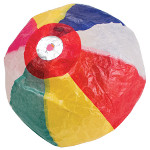 by Nancy Foote
by Nancy Foote
Two of my favorite things are bubbles and balloons. I once had a part-time job delivering balloons. How I loved that job! I learned a lot about gas laws. I found out balloons take up less volume in cold weather and expand in hot weather. (Some of those lessons I learned the hard way.) I gained plenty of insight into people… and tips… and, of course, balloons!
For instance:
- Balloons are made of a rubbery substance called latex.
- If a balloon gets a hole, it will deflate.
- You need an input of air—or some other gas—to inflate a balloon. (It’s fun when that gas is helium.)
- If you hit a balloon relatively hard against a wall, it deflates.
Imagine my surprise, then, when I discovered Educational Innovations’ Japanese paper balloons, the Paper Balloon Paradox. Not only is it made from paper, it has a permanent hole in it. To inflate, simply toss it around. The harder it’s tossed around, the faster it inflates.
Into the Classroom We Go!
 Of course this meant the Paper Balloon Paradox absolutely HAD to go on my curiosity table. It’s a table in my classroom where I put all kinds of things that I think will start a conversation with my students. I love adding new materials—anything that’ll start my students thinking about science and engineering.
Of course this meant the Paper Balloon Paradox absolutely HAD to go on my curiosity table. It’s a table in my classroom where I put all kinds of things that I think will start a conversation with my students. I love adding new materials—anything that’ll start my students thinking about science and engineering.
Truthfully though, I love putting things on this table that I want to play with. The curiosity table just gives me a legitimate reason. After all, NGSS requires us to use phenomenon—and that’s exactly what the Paper Balloon Paradox is. Just looking at the bright slices of paper sparks questions and demands further investigation.
When you get your Japanese balloons—a bargain at $8.95 for five balloons—take them out of the package carefully. (They are, after all, made of paper.) I opened them about halfway and inflated them by blowing into the hole. But I squished most of the air out of them before I gave them to students.
Students React to the Paper Balloon Paradox
The excitement, energy level, and noise in the room grew exponentially.  The students were full of questions. I had no instant answers. But then I discovered that Educational Innovations offers NGSS correlations as well as this excellent article on kamifusen (the Japanese name for the balloons) from Physics Today.
The students were full of questions. I had no instant answers. But then I discovered that Educational Innovations offers NGSS correlations as well as this excellent article on kamifusen (the Japanese name for the balloons) from Physics Today.
The author explains, “Elastic waves, fluid motion, and the paper’s plasticity work together in the self-inflation of the kamifusen. The balloon’s deceptively simple design conceals an intricate process at work and attests to the ingenuity of the artisans who devised this elegant, intriguing toy.”
Taking It a Step Further
 As part of our investigation about how these work, we decided to make our own. It looks like they’re made from tissue paper and aluminum foil. But after trying to make them, we’ve discovered that that’s not exactly true. We decided there must be something special about the paper, because making a balloon out of tissue paper does not give it the same characteristics. The balloon paper seems to have an elastic type quality the tissue paper does not. We thought the balloon must have an elastic quality or “give.” When the balloon was compressed and released, it expanded back out—thus pulling air into it. That’s what made it inflate.
As part of our investigation about how these work, we decided to make our own. It looks like they’re made from tissue paper and aluminum foil. But after trying to make them, we’ve discovered that that’s not exactly true. We decided there must be something special about the paper, because making a balloon out of tissue paper does not give it the same characteristics. The balloon paper seems to have an elastic type quality the tissue paper does not. We thought the balloon must have an elastic quality or “give.” When the balloon was compressed and released, it expanded back out—thus pulling air into it. That’s what made it inflate.
It turns out, we were onto something! The Physics Today article states,
“Part of the kamifusen’s genius is the paper from which it is made. The paper is not only lightweight and relatively impermeable to air, but it also has a degree of plasticity that allows it to deform easily and retain its resulting shape. Because of those properties, the kamifusen inflates to a volume commensurate with its air content and maintains that volume until additional air is added. As a result, a squashed kamifusen can accumulate air and eventually inflate to its full size from repeated bouncing, even though the net pumping from a single bounce may be small. A balloon made of plastic, rubber, or any other material that does not share the key properties of kamifusen paper would not inflate as the Japanese balloon does.”
Even More Ways to Use Your Paper Balloon Paradox!
Not only have we used our paper balloons as a toy and as phenomenon, we use them as a tool. We use them to choose a student—like picking a stick. Who will answer the next question, who will write the next question, who is the team leader? It could be the person who drops the ball first, or the student who’s holding the ball when the music stops. You get the idea.
These are used almost daily. I have seven sections of science. After five weeks of school so far, my balloons are still in great shape.
 The mystery behind the Paper Balloon Paradox has caught the interest, enthusiasm, and imagination of my students. In many ways, it doesn’t act like any of the balloons I’ve encountered before, but in other ways it acts exactly like the balloons I know.
The mystery behind the Paper Balloon Paradox has caught the interest, enthusiasm, and imagination of my students. In many ways, it doesn’t act like any of the balloons I’ve encountered before, but in other ways it acts exactly like the balloons I know.
My students have become emotionally entangled in trying to figure out how the balloon works. They can’t wait to get to class to try new ways to see what makes it work. If they’re thinking about science and working in teams to construct new materials, I’m all for it.
Why don’t you give it a try? It’s a win-win. These paper balloons are like a magnet the kids can’t put him down. They last a long time. They are inexpensive. What’s not to like?

